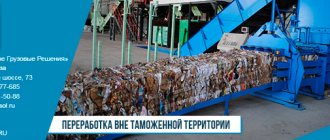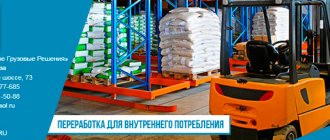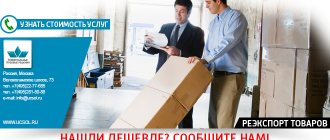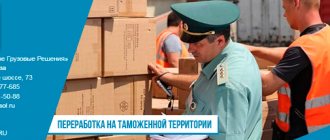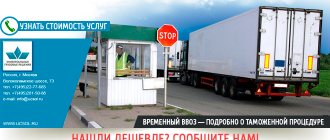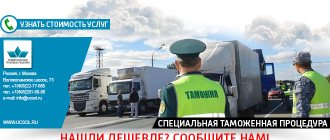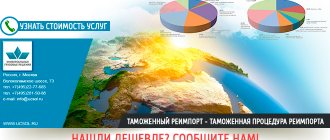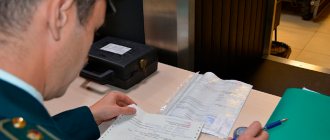HomeCustoms clearanceCustoms procedures Release for domestic consumption
Release for domestic consumption (import) is a customs procedure (formerly a customs regime) established by the EAEU Customs Code in force since January 1, 2018, which allows the use of foreign goods imported into the territory of the EAEU countries freely and without restrictions. Such goods can be sold, transported, donated, disposed of, and also perform other actions, as with goods produced within this territory.
The customs procedure code for release for domestic consumption is IM40, which is indicated when filling out column 1 of the customs declaration by a legal entity or individual entrepreneur.
Column 1 consists of three cells and is filled out as follows:
|
More details about filling
The essence and content of the procedure for releasing goods for domestic consumption
The customs procedure for the release of goods for domestic consumption is used to give imported foreign goods the status of EAEU goods and use them on the territory of the EAEU without restrictions. This means that after passing this procedure, the goods can be sold, operated, repaired or used in any other way.
To place goods under this procedure, you need to register with customs and provide the necessary package of documents, prepare and submit a declaration. It is necessary to calculate and pay all customs duties. In this case, it is very important to correctly indicate the product code according to the Commodity Nomenclature of Foreign Economic Activity according to the EAEU nomenclature. The amount of customs payments depends on it: duties, taxes, excise taxes, the application of non-tariff regulation measures, anti-dumping and countervailing duties. It is equally important to correctly determine the customs value of the goods, which is the basis for the calculation. To receive preferences, the country of origin of the product matters. If you provide a certificate of origin of the goods at customs, you can receive full or partial exemption from customs duties.
Only after checking all documents and fulfilling all requirements, as well as paying payments, customs issues a declaration, and the goods acquire the status of an EAEU product.
In addition, the customs procedure can be used when it is necessary to import goods already exported from the territory of the EAEU or to clear goods already located on the territory. To be placed under this procedure, goods must have foreign status. It is used, for example, to complete the procedures: temporary import, processing in the customs territory, processing outside the customs territory, customs warehouse.
, a conditional release of goods may be made . In this case, the goods do not acquire the status of EAEU goods, there is no need to pay customs duties for their import, but restrictions are imposed on their use (Article 126 of the EAEU Labor Code).
Special cases
The procedure for release into free circulation is formalized not only during direct import, but also during the period the goods are within the Customs Union, on the basis of a previously submitted declaration. In these cases, it is necessary to take into account a number of features. First of all, the condition that products registered in accordance with the rules for release into free circulation remain within the borders of the Customs Union does not limit the rights of authorized entities to their subsequent export from this territory. The registration procedure under consideration assumes unimpeded disposal of the cargo. Responsible persons have the right to use the products, alienate them, process them, destroy them, and perform any actions not prohibited by regulations. Objects are deprived of the status of those under control under Article 360 of the Labor Code of the Customs Union. However, the customs service reserves the right to verify the accuracy of the information specified in the declaration process. Control authorities can take advantage of this opportunity within a year from the moment the goods are released into circulation.
Rules and features of registration of foreign trade participants under the procedure of release for domestic consumption
The registration procedure for release for domestic consumption is carried out for individuals on the basis of the Decision of the EEC Council No. 107, issued on December 20, 2017.
According to this document, such persons can complete this procedure without paying taxes, duties and other fees in relation to goods intended for personal use. These can be personal items when moving internationally from abroad to permanent residence (permanent residence) or goods purchased in stores, markets, on the Internet, etc. Products can be either new or used (used). Moreover, their quantity is strictly limited depending on the type of transport and the type of product itself. When releasing for domestic consumption, some goods will require payment of customs duties. A list of them is also included in this Decision. In addition, there are rates established by law for customs duties in relation to cars and other vehicles of individuals. The amount of such fees is calculated depending on the year of manufacture and power of the vehicle. Goods not intended for personal use, recognized as a commercial consignment, cannot be placed under this procedure under any circumstances.
Issue for internal consumption for legal entities and individual entrepreneurs is carried out according to an almost identical algorithm. The main condition for performing this procedure is the payment of all necessary fees in full and the availability of all documents established by law. In addition, restrictions and prohibitions for certain goods and their groups must be observed.
Security
Guarantee of payment of prescribed import taxes and duties can be provided in various ways. In particular, the security can be presented in the form:
- Pledge of products and other property.
- Cash deposited at the cash desk or non-cash transfer to the account of the control body opened in the Treasury.
- Bank guarantee. It is issued by a financial structure present in the list of the customs authority.
- Guarantees.
The return of collateral is usually made within three days after the obligations are repaid. The reverse transfer of collateral is regulated by Article 90 of the Code. It should be noted that the request of the control service to provide guarantees for the payment of duties and taxes is considered a right, and not an obligation, of the Federal Customs Service.
Conditions for placing goods under the release procedure for domestic consumption
To place a product under the release procedure for domestic consumption , a number of conditions must be met. These conditions are slightly different for different categories of goods. Here is a list of the main conditions:
- Availability of all necessary documents;
- Payment of all necessary and provided for by the Customs Code of the EAEU customs duties and taxes in full;
- Payment of countervailing and anti-dumping duties, if provided for such goods by the above document;
- Prohibitive and restrictive measures are observed, designed primarily to provide protection and support to local manufacturers of goods with similar characteristics, properties and purposes.
Customs payments when processing release for domestic consumption
When completing the procedure for releasing goods for domestic consumption, it is necessary to calculate and pay all customs duties. In this case, it is very important to correctly indicate the product code according to the Commodity Nomenclature of Foreign Economic Activity according to the EAEU nomenclature. The amount of customs payments depends on it: duties, taxes, excise taxes, anti-dumping and countervailing duties, as well as the application of non-tariff regulation measures. It is equally important to correctly determine the customs value of the goods, which is the basis for the calculation. To receive preferences, the country of origin of the product matters. If you provide a certificate of origin of the goods at customs, you can receive full or partial exemption from customs duties. Without presenting a certificate, the benefit will not apply.
Specifics of period calculation
The deadlines for payment of import taxes and duties are as follows:
- For products declared for free circulation - before immediate release. In this case, the official registration process must be completed.
- For goods declared for the same purposes, but with the use of benefits combined with restrictions - before changes are made to the documentation indicating the refusal of benefits. Accordingly, this condition applies in the event of the subject’s reluctance to use the opportunities provided for by the rules.
- When carrying out commodity transactions with non-compliance with restrictions or violation of the goals that determine the relevant benefits - on the day of their commission, if it is established. If the exact date is unknown, the calendar date of registration of the declaration is accepted.
Registration of the customs procedure for release for domestic consumption
Ours is a customs broker (representative) and is engaged in the registration of customs procedures for the release for domestic consumption of any cargo and goods at any customs offices of the Russian Federation:
- At airports
- In seaports
- At railway stations
- At cargo automobile terminals – temporary storage warehouse
- Express postal items
If necessary, we carry out customs clearance of goods in any other customs procedures!
We work with any participants in foreign trade activities:
- Individuals
- Legal entities
- Individual entrepreneurs
Documents and information for registration of goods and cargo under the customs procedure of release for domestic consumption (IM 40)
- List of documents for registration of an individual at customs (View)
- List of documents for registration of a Legal entity at customs (View)
- List of documents for registration of an individual entrepreneur at customs (View)
- List of documents for registration of goods and cargo under the customs procedure of release for domestic consumption (View)
Termination and resumption of traceability of goods
Traceability ceases in the following cases:
- exclusion of goods subject to traceability from the List of Goods;
- disposal of goods subject to traceability, not related to sales, as a result of which the participant in the circulation of goods subject to traceability ceases to have ownership of the goods: disposal of goods subject to traceability - as a result of burial, neutralization, disposal or destruction, irretrievable loss of goods due to force majeure force, confiscation, as well as in connection with the transfer of goods subject to traceability into production and (or) processing, including as customer-supplied raw materials (materials), components, for the manufacture of new goods;
- sale, as well as transfer, free of charge, of ownership of goods subject to traceability to individuals for use for personal, family, household and other purposes not related to business activities, as well as to taxpayers of professional income tax;
- actual export from the territory of the Russian Federation of goods subject to traceability in accordance with the customs procedure for export (re-export);
- export of goods subject to traceability from the territory of the Russian Federation to the territory of another EAEU member state;
- sales of goods subject to traceability to diplomatic missions and consular offices, representative offices of states at international organizations, international organizations or their representative offices enjoying privileges and (or) immunities in accordance with international treaties of the Russian Federation, subject to the subsequent official use of these goods;
- shortage of goods subject to traceability, identified by a participant in the circulation of goods subject to traceability during inventory (clause 4 of the Procedure).
Traceability is resumed in the following cases:
- return of remnants of unused (unprocessed) goods from production (processing), for which traceability was subject to termination in accordance with subparagraph 2 of paragraph 4 of the Procedure;
- return to the seller by individuals of goods subject to traceability previously sold to individuals for personal, family, household and other non-business needs, as well as refund by taxpayers of professional income tax, goods subject to traceability previously sold to taxpayers of professional tax income;
- identification by a participant in the circulation of goods subject to traceability during the inventory of goods subject to traceability, for which a shortage was previously identified (clause 5 of the Procedure).

